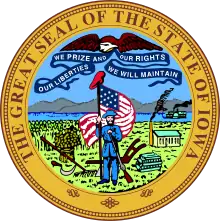Johnson County, Iowa
Johnson County is located in the U.S. state of Iowa. As of the 2010 census, the population was 130,882[1] making it the fifth-most populous county in Iowa. The county seat is Iowa City,[2] home of the University of Iowa.
Johnson County | |
|---|---|
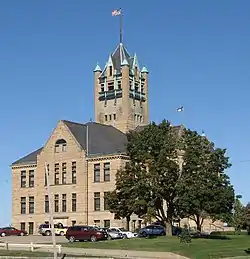 | |
 Seal | |
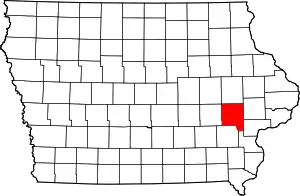 Location within the U.S. state of Iowa | |
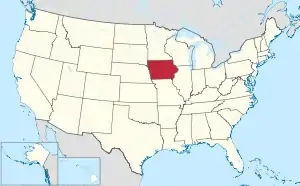 Iowa's location within the U.S. | |
| Coordinates: 41°40′00″N 91°35′00″W | |
| Country | |
| State | |
| Founded | December 21, 1837 |
| Named for | Lulu Johnson, Richard Mentor Johnson |
| Seat | Iowa City |
| Largest city | Iowa City |
| Area | |
| • Total | 623 sq mi (1,610 km2) |
| • Land | 614 sq mi (1,590 km2) |
| • Water | 9.1 sq mi (24 km2) 1.5% |
| Population (2010) | |
| • Total | 130,882 |
| • Estimate (2019) | 151,140 |
| • Density | 210/sq mi (81/km2) |
| Time zone | UTC−6 (Central) |
| • Summer (DST) | UTC−5 (CDT) |
| Congressional district | 2nd |
Johnson County is included in the Iowa City metropolitan area, which is also included in the Cedar Rapids-Iowa City Corridor Combined Statistical Area.[3]
History
Johnson County was established in December 1837 by the legislature of the Wisconsin Territory, one of thirteen counties established by that body in a comprehensive act.[4] The county's area was partitioned from Dubuque County, and was not initially provided with a civil government, instead being governed by Cedar County officials. It was named for the US Vice President Richard M. Johnson.[5] In 2020 the county board of supervisors unanimously renamed the county after historian Lulu Merle Johnson.[6] It is one of two counties named after an African American, along with King County, Washington.
The first courthouse in the county was a two-story log cabin structure, built in 1838 in the settlement of Napoleon,[7] about two miles south of the current courthouse.[8] The building stood across from what later would become the James McCollister Farmstead on land later owned by Philip Clark.
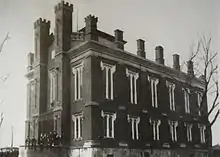
After Iowa City was established by fiat as the new territorial capitol of Iowa, the county seat was removed there.[9] The second Johnson County Courthouse, the first in Iowa City, was built on Lot 8 Block 8 of the County Seat Addition to Iowa City in 1842 for $3,690.[8] This location was in the southeast corner of the intersection of Harrison and Clinton Streets. The building was 56 x 28 feet and two stories tall.[10] It was built by James Trimble, who had previously built the first jail.[8]
A third courthouse was built in 1857 in the courthouse square on Clinton Street between Court and Harrison Streets. It was used until 1901, after cracks appeared in its south wall in 1899.[11] The building was apparently built of brick with stone and wood ornamentation.[12]
The Richardsonian Romanesque style courthouse in use today was designed by the firm of Rush, Bowman and Rush of Grand Rapids, Michigan.[13] It was bid at a cost of $111,000 and built by the firm Rowson & Son of Johnson County.[14] The cornerstone was laid in December 1899.[15] The building's tower was based on Henry Hobson Richardson's design for the spire of Trinity Church in Boston.[16] The building was dedicated on June 8, 1901.[17] The currently unused jail that stands to the west of the courthouse was designed by C.L. Wundt of Burlington, Iowa on behalf of the Stewart Iron Works in Cleveland and bid for $14,000.[18]
Geography
According to the U.S. Census Bureau, the county has a total area of 623 square miles (1,610 km2), of which 614 square miles (1,590 km2) is land and 9.1 square miles (24 km2) (1.5%) is water.[19]
Major highways
Adjacent counties
- Benton County – northwest
- Cedar County – east
- Iowa County – west
- Linn County – north
- Muscatine County – east and southeast
- Louisa County – southeast and south
- Washington County – south
- Iowa County – west
Demographics
| Historical population | |||
|---|---|---|---|
| Census | Pop. | %± | |
| 1850 | 4,472 | — | |
| 1860 | 17,573 | 293.0% | |
| 1870 | 24,898 | 41.7% | |
| 1880 | 25,429 | 2.1% | |
| 1890 | 23,082 | −9.2% | |
| 1900 | 24,817 | 7.5% | |
| 1910 | 25,914 | 4.4% | |
| 1920 | 26,462 | 2.1% | |
| 1930 | 30,276 | 14.4% | |
| 1940 | 33,191 | 9.6% | |
| 1950 | 45,756 | 37.9% | |
| 1960 | 53,663 | 17.3% | |
| 1970 | 72,127 | 34.4% | |
| 1980 | 81,717 | 13.3% | |
| 1990 | 96,119 | 17.6% | |
| 2000 | 111,006 | 15.5% | |
| 2010 | 130,882 | 17.9% | |
| 2019 (est.) | 151,140 | [20] | 15.5% |
| U.S. Decennial Census[21] 1790-1960[22] 1900-1990[23] 1990-2000[24] 2010-2019[1] | |||
2010 census
The 2010 census recorded a population of 130,882 in the county, with a population density of 212.9964/sq mi (82.2384/km2). There were 55,967 housing units, of which 52,715 were occupied.[25]
2000 census

As of the census[26] of 2000, there were 111,006 people, 44,080 households, and 23,582 families residing in the county. The population density was 181 people per square mile (70/km2). There were 45,831 housing units at an average density of 75 per square mile (29/km2). The racial makeup of the county was 90.13% White, 2.90% Black or African American, 0.28% Native American, 4.12% Asian, 0.04% Pacific Islander, 1.01% from other races, and 1.51% from two or more races. 2.51% of the population were Hispanic or Latino of any race.
There were 44,080 households, out of which 26.50% had children under the age of 18 living with them, 43.90% were married couples living together, 6.80% had a female householder with no husband present, and 46.50% were non-families. 30.20% of all households were made up of individuals, and 5.60% had someone living alone who was 65 years of age or older. The average household size was 2.34 and the average family size was 2.97.
Age spread: 20.10% under the age of 18, 23.40% from 18 to 24, 30.80% from 25 to 44, 18.20% from 45 to 64, and 7.40% who were 65 years of age or older. The median age was 28 years. For every 100 females, there were 99.10 males. For every 100 females age 18 and over, there were 97.30 males.
The median income for a household in the county was $40,060, and the median income for a family was $60,112. Males had a median income of $36,279 versus $29,793 for females. The per capita income for the county was $22,220. About 5.20% of families and 15.00% of the population were below the poverty line, including 8.10% of those under age 18 and 3.80% of those age 65 or over.
Politics
Largely due to the presence of the University of Iowa, Johnson County is considered the most liberal county in Iowa and a stronghold of the Democratic Party. It has been the strongest Democratic county in the state since 1984. This trend predates the recent swing toward the Democrats in counties influenced by college towns. The last Republican to win the county in a presidential election was Richard Nixon in 1960, and the last Republican to even get 40 percent of the county's vote was Ronald Reagan in 1984. As a measure of how strongly Democratic the county has been, Democrats easily carried it even in the national Republican landslides of 1972, 1984 and 1988.
Johnson County's Democratic bent is just as pronounced at the state level. It is often the lone county to vote Democratic in statewide Republican landslides, such as Senator Chuck Grassley's re-elections in 2010 and 2016 or Governor Terry Branstad's re-election in 2014.
| Year | Republican | Democratic | Third Parties |
|---|---|---|---|
| 2020 | 27.3% 22,925 | 70.6% 59,177 | 2.1% 1,749 |
| 2016 | 27.4% 21,044 | 65.3% 50,200 | 7.4% 5,696 |
| 2012 | 31.2% 23,698 | 66.7% 50,666 | 2.1% 1,613 |
| 2008 | 28.4% 20,732 | 69.9% 51,027 | 1.7% 1,230 |
| 2004 | 34.8% 22,715 | 64.0% 41,847 | 1.2% 811 |
| 2000 | 33.9% 17,899 | 59.1% 31,174 | 7.0% 3,696 |
| 1996 | 29.3% 13,402 | 61.0% 27,888 | 9.7% 4,442 |
| 1992 | 27.1% 14,041 | 55.4% 28,656 | 17.5% 9,077 |
| 1988 | 34.6% 15,453 | 64.4% 28,759 | 1.0% 435 |
| 1984 | 41.5% 18,677 | 57.7% 26,000 | 0.8% 367 |
| 1980 | 31.7% 13,642 | 46.8% 20,122 | 21.5% 9,233 |
| 1976 | 41.6% 16,090 | 52.2% 20,208 | 6.2% 2,412 |
| 1972 | 40.9% 14,823 | 57.7% 20,922 | 1.4% 491 |
| 1968 | 43.9% 11,384 | 52.2% 13,541 | 3.9% 1,019 |
| 1964 | 31.7% 6,860 | 68.1% 14,717 | 0.2% 41 |
| 1960 | 50.8% 10,927 | 49.1% 10,563 | 0.1% 18 |
| 1956 | 56.3% 11,298 | 43.7% 8,767 | 0.1% 11 |
| 1952 | 58.0% 11,231 | 41.7% 8,067 | 0.3% 52 |
| 1948 | 43.8% 7,139 | 52.8% 8,611 | 3.4% 553 |
| 1944 | 42.9% 6,396 | 56.6% 8,434 | 0.5% 67 |
| 1940 | 44.3% 7,206 | 55.4% 9,017 | 0.3% 55 |
| 1936 | 38.2% 5,629 | 59.7% 8,794 | 2.2% 320 |
| 1932 | 37.9% 5,484 | 60.5% 8,764 | 1.6% 235 |
| 1928 | 50.3% 7,288 | 49.5% 7,181 | 0.2% 29 |
| 1924 | 44.5% 5,741 | 35.5% 4,570 | 20.0% 2,580 |
| 1920 | 52.2% 5,696 | 46.1% 5,032 | 1.8% 195 |
| 1916 | 42.2% 2,704 | 57.0% 3,650 | 0.8% 49 |
| 1912 | 28.0% 1,645 | 56.5% 3,327 | 15.5% 914 |
| 1908 | 44.8% 2,758 | 53.9% 3,314 | 1.3% 79 |
| 1904 | 48.3% 2,963 | 50.3% 3,085 | 1.5% 91 |
| 1900 | 48.1% 3,010 | 50.9% 3,182 | 1.1% 66 |
| 1896 | 47.1% 2,910 | 51.3% 3,170 | 1.7% 104 |
| 1892 | 39.4% 2,179 | 58.3% 3,227 | 2.4% 131 |
| 1888 | 40.2% 2,051 | 59.5% 3,038 | 0.4% 19 |
| 1884 | 38.7% 2,019 | 60.4% 3,151 | 0.9% 46 |
| 1880 | 44.9% 2,400 | 51.7% 2,766 | 3.4% 180 |
Communities
Cities
Census-designated place
Other unincorporated communities
Ghost towns
Townships
Population ranking
The population ranking of the following table is based on the 2010 census of Johnson County.[29]
† county seat
| Rank | City/Town/etc. | Municipal type | Population (2010 Census) |
|---|---|---|---|
| 1 | † Iowa City | City | 67,862 |
| 2 | Coralville | City | 18,907 |
| 3 | North Liberty | City | 13,374 |
| 4 | West Branch (mostly in Cedar County) | City | 2,322 |
| 5 | Solon | City | 2,037 |
| 6 | Tiffin | City | 1,947 |
| 7 | Lone Tree | City | 1,300 |
| 8 | University Heights | City | 1,051 |
| 9 | Swisher | City | 879 |
| 10 | Oxford | City | 807 |
| 11 | Hills | City | 703 |
| 12 | Shueyville | City | 577 |
| 13 | Frytown | CDP | 165 |
Notable natives
- John T. Struble (1831–1916) early builder and farmer.
- Grant Wood, artist.
References
- "State & County QuickFacts". United States Census Bureau. Archived from the original on June 7, 2011. Retrieved July 18, 2014.
- "Find a County". National Association of Counties. Archived from the original on May 3, 2015. Retrieved June 7, 2011.
- United States Office of Management and Budget. "Update of Statistical Area Definitions and Guidance on Their Uses" (PDF). pp. 5, 36. Archived from the original (PDF) on May 14, 2006. Retrieved July 21, 2006.
- The other counties created on December 21, 1837: Benton, Buchanan, Cedar, Clayton, Clinton, Delaware, Fayette, Jackson, Jones, Keokuk, Linn, and Scott.
- History of Johnson County, Iowa 1836-1882 (1883). Reproduction by Unigraphic Inc. pp. 165-6.
- "Johnson County switches its namesake from slave owner to Black scholar". The Gazette.
- This no longer exists as a separate settlement but as part of Iowa City. Its former existence is recognized by the present Napoleon Park, accessed via Napoleon Lane (41.63350N, 91.53147W). Napoleon Lane Google Maps (accessed 18 August 2018)
- Aurner, p. 492.
- Aurner, pp. 47, 72.
- Aurner, pp. 21, 492.
- Aurner, p. 494.
- Aurner, p. 65.
- Daily Iowa State Press, April 1, 1899, p. 5
- Aurner, pp. 496-7.
- Aurner, p. 496.
- "The Johnson County Courthouse". Archived from the original on June 17, 2008. Retrieved July 14, 2008.
- Aurner, p. 496
- Aurner, p. 497.
- "US Gazetteer files: 2010, 2000, and 1990". United States Census Bureau. February 12, 2011. Retrieved April 23, 2011.
- "Population and Housing Unit Estimates". Retrieved May 21, 2020.
- "U.S. Decennial Census". US Census Bureau. Retrieved July 18, 2014.
- "Historical Census Browser". University of Virginia Library. Retrieved July 18, 2014.
- "Population of Counties by Decennial Census: 1900 to 1990". US Census Bureau. Retrieved July 18, 2014.
- "Census 2000 PHC-T-4. Ranking Tables for Counties: 1990 and 2000" (PDF). US Census Bureau. Retrieved July 18, 2014.
- "Population & Housing Occupancy Status 2010". US Census Bureau – American FactFinder. Retrieved May 19, 2011.
- "U.S. Census website". US Census Bureau. Retrieved January 31, 2008.
- Leip, David. "Dave Leip's Atlas of U.S. Presidential Elections". uselectionatlas.org. Retrieved April 26, 2018.
- http://geoelections.free.fr/. Retrieved January 13, 2021. Missing or empty
|title=(help) - "2010 U.S. Census website". United States Census Bureau. Retrieved February 13, 2016.
- Charles Ray Aurner, Leading Events in Johnson County, Iowa, History, Volume I (1912) reproduction by Torch Press, Cedar Rapids IA
External links
| Wikimedia Commons has media related to Johnson County, Iowa. |
